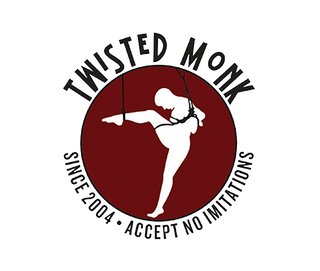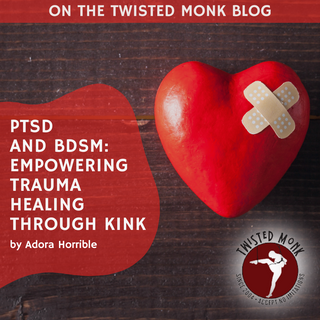By Adora Horrible
AKA Shira Behal, LCPC, AT
The structured vulnerability of BDSM creates space for pleasure, healing from trauma, healthy confronting of shame, and deep connection…when practiced alongside therapy with informed risk awareness.
This is an academic and personal topic for me. I have engaged my own demons, facing them with my therapist, for the last 19 years. Now I have an average amount of demons left, and pulling them out is a friendly scrimmage compared to the inner life and death battles I used to wage. I would not have gotten here without the growth I experienced in the kink community.
I want to be clear that BDSM is therapeutic, but it is NOT therapy. There may be harm instead of healing if PTSD is not cared for in a therapy informed way. So first, some background.
PTSD is a response to trauma that causes severe life impairment long after the trauma is over. C-PTSD is the same but from smaller repeated traumas rather than one event. Both may be characterized by intrusive thoughts of the trauma, dissociation (where the brain checks out when overwhelmed; this looks like non-responsiveness, staring off into space, or sleeping) flashbacks, nightmares, panic attacks, and difficulty with mood, relationships, boundaries, and executive function.
THE RELATIONSHIP BETWEEN PTSD AND BDSM
A lot of what we do in BDSM mimics trauma, but in a safe as possible, consensual, stopped at will way. That’s the draw! It’s a playground to experiment with our responses. It promotes acceptance, tolerance, and a sense of safety and control. Kinks often have roots in formative memories or experiences (traumatic or not.) Kinks can evoke comfort, or difficulty, or an enticing combination of the two. (Behaviorists, eat your heart out.)
It’s important to remember that BDSM may seem serious and deals with heavy issues and risks…. But it is supposed to be fun! And full of *enthusiastic* consent. It’s not like the abuse portrayed in popular media like 50 Shades of Gray.
The terms “scene” and “play” are used because, just like children pretending to be Batman, (here), playfulness and pretending reduce stress and stakes, allowing our brains to practice and learn real skills. The children pretending to be Batman become better problem solvers with more perseverance and BDSM is pretend play for adult concepts that can help people learn, grow, and heal as well.
So, to illustrate what using BDSM as a healing tool for PTSD could look like, we’ll use the hypothetical story of Jane, a compilation of true stories.
Jane had a severe trauma in their life. They had trouble being intimate afterwards. They felt a lot of shame. They had trouble feeling safe. Being touched by their partner would trigger traumatic flashbacks. They would scream and shake and dissociate. Sometimes they could have sex like a drug, but they had to be “checked out” emotionally. They even had urges to hurt themself, because it seemed to provide an escape from the strong feelings and a sense of control over their body.
Jane saw a therapist, who worked with them on skills to bring their distress level down, and start functioning better through their day. At their therapist’s suggestion, Jane began reading erotica, and found *some* kinky things that felt good to think about. After reaching a baseline of skills in daily life, they tried applying these skills to the BDSM activities that interested them, and found joy in these new experiences.
Jane found that when being intimate, they like to suck on things- cocks, fingers, feet, nipples…. They feel safe in the vulnerability of intimacy while doing this.
They also enjoy being spanked and whipped, because they can experiment with their own nervous system and learn to re-regulate it. Unlike self-injury, this isn’t to escape, and it’s never done alone. They can experiment with what their body can handle, challenging themself to build tolerance and practice acceptance without shutting down (a warm up, an endorphin rush, window of tolerance levels, eventual need to stop).
Using check-ins and safe words helped restore a sense of safety around experiencing their body, and trust in others. Of course, Jane always seeks guidance from their therapist after a difficult scene. They do not expect to process trauma or get skills to move forward from their untrained partner.
Jane found that the helplessness they felt during their trauma could be evoked and processed with rope bondage. Being tied up brings them both comfort and confrontation. They enjoy something to struggle against, and to practice acceptance within. They also feel able to connect with their scene partner through the tension of the rope, even when they can’t see them, which they find reassuring. ¹
Shame is another aspect of Jane’s trauma BDSM has helped them process. Dialectic Behavioral Therapy says the best counter to shame is sharing in a safe way with someone you know won’t judge. Jane really liked finding a community around kink that was so open and accepting. They were able to share what they held shame around and feel completely accepted…even desired. After a while, the shame melted. Their desires became something sexy, joyful, and powerful. ²
In aftercare, they ask for and receive what they need to feel safe and cared for. They did not receive that kind of care after their trauma, so getting it now helps create a new narrative around old emotional pain. They practice skills they are working on in therapy to ask for support instead of suffering alone. Additionally, every time Jane negotiates a scene (See this written negotiation sheet for reference) they get proof their wants and needs matter.
Sometimes, Jane does scenes for connection and fun. Other times, Jane talks with their therapist about specific things from their past they want to address in a scene. Sometimes it’s the other way around- they tried something that brought new perspective on their past.
Jane’s experiences are so effective at healing because the brain, body, and emotions need repeated experience to believe something that they used to fear is safe. You don’t always believe what you just TELL yourself verbally. Our emotional selves need to see and feel things to believe it. Repeatedly. Going through BDSM experiences successfully makes Jane believe they’re a badass. They have restored the emotional confidence to face challenging situations, trust other people, and trust themselves to get through things skillfully.
HOW TO PLAY RISK AWARE WITH TRAUMA
- Jane knows that THEIR KINK PARTNER IS NOT THEIR THERAPIST. (Partners can help, but it should be in ways you specifically ask for and they consent to provide.)
- Do not misuse the term “Exposure therapy.” Jane knows that White knuckling (forcing) their way through is NOT exposure therapy. It is, however, a great way to re-traumatize them.
Actual exposure therapy is a structured, guided process with a professional that ensures you have new skills BEFORE facing challenges.
If Jane notices trauma reactions that make them dysfunctional are happening often, they will change their play and consult their therapist.
- Understand dissociation. Dissociation happens when your body says you are too distressed, so it’s going to check out and rest. Eyes unfocus or close, you become less aware of your environment, and less responsive. Sometimes you keep functioning on “instinct” but without your full awareness. It can be scary if you don’t know why and can’t make it stop. If it happens, the best plan is to stop the distress and relax into the dissociation. Pay special attention to your 5 senses- sight, sound, touch, smell, taste… until it fades on its own and you feel more grounded.
Jane likes to use a 1-10 distress level scale, which lets a top check in or bottom speak up without breaking the scene, to prevent them from reaching dissociation. They stay in their “window of tolerance,” where they feel challenged but not overwhelmed. Decide together before you begin what number you want to stay around, and what number is too high.
Flashbacks and panic attacks should be addressed differently. Discuss a plan with your individual therapist if you or your partner experience these issues.
- Fourth and most important, create a preparedness plan that helps you communicate what your PTSD (or your partner’s PTSD) might look like, and how to address it. That way, if a PTSD reaction does occur, it gets handled well and play can resume. A plan can sound scary, but so can a fire preparedness plan. Let your partner know you don’t intend to start a fire or expect one, but you want them to know what to do if it happens.
These reactions can be scary for either party, so if play does end, make sure everyone knows why, and reaffirm that everyone is safe. Additionally, having a positive resolution to a trauma trigger can be powerfully healing.
Consult your individual therapist for your preparedness plan…. here is some examples from Jane’s plan:
- Usual hard and soft limits, and things they love.
- Any known triggers to avoid
- Specific issues to look out for. I.e.:
If I have a panic attack:
It looks like: hyperventilation and frantic movement.
What I can do about it: I can usually say yellow, and maybe qualify with the word panic. If I can’t, I can give a nonverbal safeword: tapping or banging in rhythm.
Do: Say calming things reminding me I am safe. Tell me where we are, the date, what time it is, and what we are doing. Sit close to me. Let me hold your hand if I reach for you. Breathe deeply and slowly next to me. Bring water. Wait.
Do not: ask me what’s wrong. Try to get me to speak before I’m ready. Touch me unless I initiate. Offer any other suggestions like a paper bag etc. Tell me to calm down, or to breathe.
Remember these are general tools to empower you and your partners to find control, vulnerability, connection, and emotional freedom as safely as possible. Consult your individual therapist. And of course, don’t forget to have fun!
Happy Kinking,
Adora Horrible
- I have had some clients use rope as part of art therapy exercises, and with couples for enhanced communication. We were actually taught some of these exercises in school using yarn, and it’s the same with rope except thicker and easier to feel. Even simply holding a rope during discussion creates a new layer for couples, where they can see and feel underlying tensions. Imagine creating something physical from that together, and being wrapped in it, and able to move around dynamically within it. Rope is a powerful tool for communication and healing. If you’re interested in deepening your rope practice, here is a link to some resources to learn what to do with your rope https://www.twistedmonk.com/collections/books-and-more)
- I also think every kinkster should watch this Brenee Brown Ted Talk on vulnerability; in my opinion it’s the heart of what we do https://www.ted.com/talks/brene_brown_the_power_of_vulnerability?language=en
Adora Horrible, AKA Shira Behal, MA, LCPC, AT
Has been a practicing Psychotherapist and Art Therapist since 2016 in community mental health and now private practice.
They have been a member of the Chicago kink community since 2005. Their art hangs in a local dungeon, and they have taught classes in the community.
They are a gender fluid pansexual polyamorous switch, and are diagnosed with Autism, ADHD and PTSD. So, they speak about mental health and kink topics from both personal experience and academic education.
When asked, friends described them as “Tall, dark, and oh so handsome” (they are 4’11” and pale as a ghost, but it’s an attitude); “a bodacious aspirational athlete” (they are plus sized and completing triathlons); “BAMF”; and “kind, curious, analytical, tenacious, spunky, affirming, empathetic, and fully engaged.”

